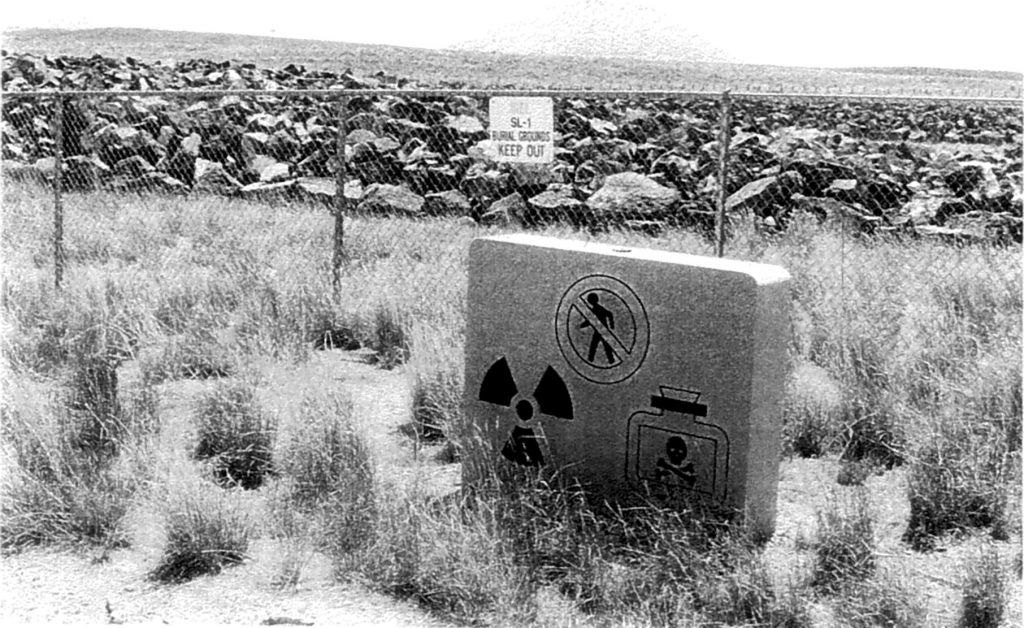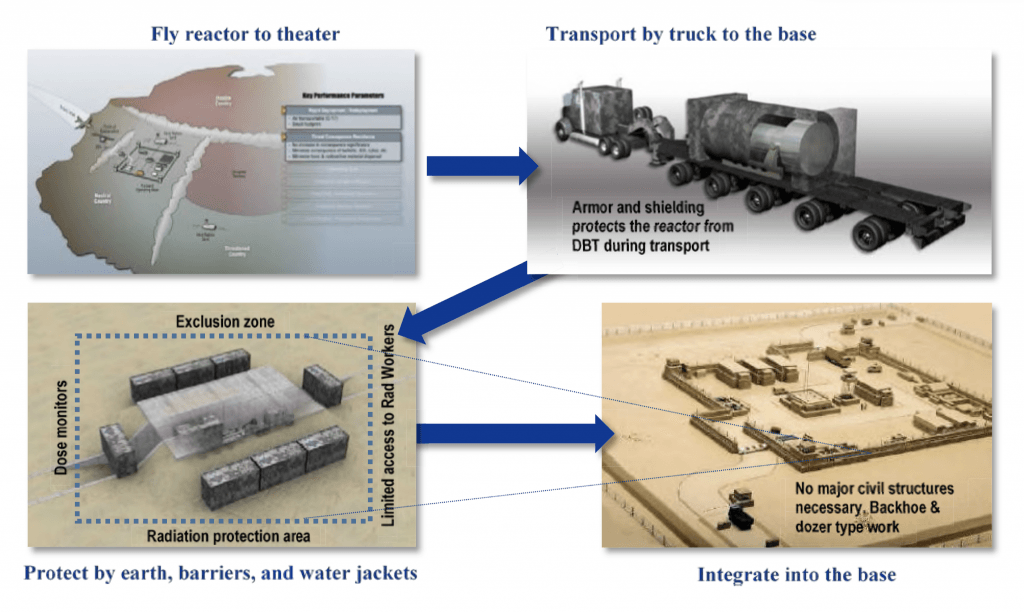The Pentagon wants to boldly go where no nuclear reactor has gone before. It won’t work.
By Edwin Lyman | February 22, 2019
Two experimental mobile nuclear reactor designs, a half-century apart: Los Alamos National Laboratory’s “Megapower” new mobile nuclear reactor concept and the 1960s ML-1 army reactor.
In January, the Defense Department issued a call for information in support of the aptly titled Project Dilithium. It seeks to develop a tiny, readily transportable, yet virtually indestructible nuclear power reactor for use at forward operating bases, the military facilities that provide logistical and troop support to the front-lines of conflict zones.
The Pentagon presumably chose the name to convey a futuristic image—at least, to the Star Trek aficionados among us. Make no mistake, however: The project, with its naïve optimism that such reactors “have the potential to be an across-the-board strategic game changer,” is less Captain James T. Kirk and more Lieutenant General Samuel D. Sturgis, who founded the now-defunct Army Nuclear Power Program more than sixty years ago.
Project Dilithium’s name isn’t its only science fiction-related aspect. To be sure, the type of reactor it is seeking could be a great military asset: all the benefits of nuclear energy with none of the risks. The costly and dangerous process of trucking diesel fuel to bases, sometimes through hostile territory, may eventually be a thing of the past. Unfortunately, the need to store and ship irradiated nuclear fuel in a war zone will introduce different problems. And the odds that a meltdown-proof reactor could be successfully developed any time soon are vanishingly small.
The quest for a safe modular reactor
The Army Nuclear Power Program was initiated in 1954, in the heady early days of the atomic power era, to develop ground-based nuclear power plants for military use—a mission distinct from the Navy’s submarine nuclear propulsion program already well underway. Over two decades, the US Army built and operated eight small power reactors, ranging from less than one megawatt to ten megawatts of electricity, with limited success. The worst outcome was the 1961 core meltdown and explosion at the SL-1 reactor in Idaho, which killed three operators. Five of the reactors were designed to be portable to some degree, and three were deployed at remote military bases in Greenland, Alaska, and Antarctica. Although these reactors didn’t explode, they proved unreliable and expensive to operate. Based on that experience, the program was shut down in 1977.
Over the same period, the civil nuclear power industry became established and was relatively successful. Commercial nuclear plants got bigger, in part because they produce cheaper electricity than small plants through economies of scale. They also experienced a number of meltdowns, including Three Mile Island in 1979 and Fukushima in 2011, that shook confidence in the safety of the technology. But today, a new generation of commercial vendors are marketing small nuclear plants that they claim are less costly and super-safe, and the Pentagon apparently wants to get back in the game.

The Defense Department’s request for information (RFI) was issued on January 18 by the Strategic Capabilities Office, which reports to the Under Secretary of Defense for Research and Engineering. It seeks information on “innovative technologies and approaches” for demonstration of a prototype reactor with a threshold power of 1 to 10 megawatts of electricity. The RFI specifies that the reactor, at a minimum, should be less than 40 tons total weight; small enough to be transported by truck, ship, and aircraft; able to run for at least three years without refueling; and capable of semi-autonomous operation.
While these specs set high standards, they are probably not insurmountable. The greater challenges arise in meeting the RFI’s safety criteria: the reactor should have an “inherently safe design” that ensures “a meltdown is physically impossible in various complete failure scenarios;” cause “no net increase in risk to public safety … by contamination with breach of primary core;” and have “minimized consequences to nearby personnel in case of adversary attack.”
These requirements, obviously, are key. Nuclear reactors deployed at forward operating bases or shipped through war zones would be prime targets of the enemy. An Octrober 2018 report commissioned by the army’s Deputy Chief of Staff admits, quite reasonably, that exposed mobile nuclear plants would “not be expected to survive a direct kinetic attack.” If commanders need to expend significant resources to protect the reactors or their support systems from military strikes, such reactors could become burdens rather than assets.

Can one really invent a reactor robust enough to suffer such a strike without causing unacceptable consequences? The “inherently safe reactor” has been a nuclear industry catchphrase for decades, but the reality has never matched the rhetoric. All it really means is that in certain idealized scenarios, a reactor, after shutdown, could be adequately cooled by passive mechanisms, such as convective airflow. But passive safety cannot eliminate every pathway by which the reactor fuel could be damaged and release radioactivity. If a severe accident or sabotage attack were to induce more extreme conditions than the reactor was designed to withstand, all bets are off. How long would passive airflow keep nuclear fuel safely cool if, say, an adversary threw an insulating blanket over a small reactor? Or if the reactor were buried under a pile of debris?
Moreover, it is hard to imagine that a direct explosive breach of the reactor core would not result in dispersal of some radioactive contamination. An operating nuclear reactor is essentially a can filled with concentrated radioactive material, including some highly volatile radionuclides, under conditions of high pressure and/or temperature. Even a reactor as small as 1 megawatt-electric would contain a large quantity of highly radioactive, long-lived isotopes such as cesium-137—a potential dirty bomb far bigger than the medical radiation sources that have caused much concern among security experts. Operating the reactor for long cycle lengths, another RFI requirement, would increase the quantity of fission products available for release.
At best a release of radioactivity would be a costly disruption, and at worst it would cause immediate harm to personnel, render the base unusable for years, and alienate the host country. For any reactor and fuel design, extensive experimental and analytical work would be needed to understand how much radioactivity could actually escape after an attack and how far it would disperse. This is also true for spent fuel being stored or transported.
Such research is time-consuming, but proponents of micro-reactors want to move fast. The 2018 US Army report refers to a demonstration date of 2023, and the Idaho National Laboratory (INL), which hopes to return to its glory days as a site for building and testing experimental reactors, believes that with sufficient resources it can demonstrate such a reactor as early as 2021. To have even the slightest chance of meeting such aggressive deadlines, high-maturity reactor designs would already have to be on the shelf and construction-ready. But the options available today do not provide cause for optimism.
Megapower: a small, safe and reliable #nuclear power plant for remote towns, military bases, and other isolated infrastructure. https://t.co/cumazI3L3v pic.twitter.com/7Y2hyeeYW9
— Los Alamos Lab (@LosAlamosNatLab) February 15, 2019
Flawed designs
The 2018 report describes several existing reactor concepts that it thinks might meet its needs. One is the 2 megawatt-electric “Megapower” reactor being designed by Los Alamos National Laboratory. But a 2017 INL study of the design identified several major safety concerns, including vulnerabilities to seismic and flooding events. The study also found that the reactor lacked sufficient barriers to prevent fission product release in an accident. INL quickly developed two variants of the original Los Alamos design, but a subsequent review found that those shared many of the safety flaws of the original and introduced some new ones.
The other designs are high-temperature gas-cooled reactors that use TRISO (“tristructural isotropic”) fuel, which was originally developed decades ago for use in reactors such as the now-decommissioned Fort St. Vrain plant in Colorado. TRISO fuel consists of small particles of uranium coated with layers of different materials designed to retain most fission products at temperatures up to 1,600 degrees Celsius.
TRISO fuel enthusiasts have long claimed that reactors utilizing it do not need containments because each particle essentially has its own. This would seem to make TRISO an ideal fuel for small, mobile reactors, which can’t be equipped with the large, leak-tight containment structures typical of commercial power reactors. The army report buys into the notion that these “encapsulated” nuclear fuels can “avoid the release of radioactive volatile elements” and prevent contamination of the surrounding area, either during normal operations or accidents.
TRISO fuel’s actual performance has been inconsistent, however, and much is still not known. The Energy Department has been carrying out a program for more than a decade to try to improve TRISO fuel, but final results are not expected for years. In addition, if the fuel temperature rises above 1,600 degrees Celsius, fission product release can rapidly increase, making it vulnerable to incendiary weapons that burn hotter, such as thermite. And the ubiquitous presence of graphite in gas-cooled reactors—the combustible material that brought the world an 11-day radioactive fire after the April 1986 Chernobyl explosion—introduces other dangers. Because graphite can oxidize at high temperature, gas-cooled reactors must be protected from small breaches that could allow air or water to come into contact with their cores.
The Defense Department may have already realized that TRISO fuel is not as miraculous as it first thought. The initial January 18 RFI specified that the core designs had to use “advance (sic) gas reactor TRISO fuel,” but this condition was missing from a revised request the department issued four days later.
The RFI also specifies that the reactor should be capable of being transported within seven days after shutdown, presumably with the irradiated nuclear fuel still inside. While this requirement is understandable—if forces need to retreat in a hurry, they would not want to leave the reactor behind—it is unrealistic to expect this could be met while ensuring safety. Typically, spent nuclear fuel is stored for many months to years after discharge from a reactor before regulators allow it to be shipped, to allow for both thermal cooling and decay of short-lived, intensely radioactive fission products. Moving a reactor and its irradiated fuel so soon after shutdown could be a risky business.
Even after the spent fuel is removed, it may not be that easy to move the rest of the reactor quickly. The Pentagon should appreciate that from its experience with the small reactors that it built and operated during the Army Nuclear Power Program—such as the 2 megawatt-electric reactor at Fort Belvoir, Virginia, which it is dismantling only now, after waiting 45 years for residual radioactivity to decay away.
The proliferation threat
Finally, the proliferation risks of these reactors and their fuel is a concern. The original RFI stipulated that the reactor fuel had to be high-assay low-enriched uranium (HALEU), which is uranium enriched to levels above the 5 percent uranium-235 concentration of conventional power reactors, but still below the 20 percent that marks the lower limit for highly enriched uranium (HEU), which is usable in nuclear weapons. Although HALEU is considered highly impractical for direct nuclear weapons use, it has greater proliferation potential than fuel with uranium-235 concentrations below 5% because of the reduced effort needed to enrich it to a weapon-usable level—which is why the international community saw Iran’s stockpiling of HALEU as a threat. If the Defense Department goes forward with Project Dilithium, other nations, including US adversaries, may be prompted to start producing HALEU and building their own military power reactors.
An even more worrisome problem is that the revised RFI issued on January 22 no longer includes the HALEU requirement. That opens the door for reactors fueled with HEU—a major proliferation threat. The Defense Department may be envious of NASA, which is moving forward with development of a tiny HEU-fueled reactor to power deep space missions while turning a blind eye to the proliferation risks. Or it may have decided that the current lack of availability of a sufficient quantity of HALEU for a demonstration reactor would cause an unacceptable delay. Or the omission may simply be a mistake. As of this writing, the contracting officer at Defense has not responded to a request to clarify whether this was an innocuous oversight or a deliberate gesture.
Given the dubious strategic value, low chance of success, and potential for sparking a HALEU-fueled international arms race, what can explain the Defense Department’s renewed interest in small reactors after decades of dormancy? To be sure, Project Dilithium didn’t just spring out of nowhere. It is the culmination of a patient, decade-long effort by nuclear lobbyists to interest Defense and its congressional overseers in a costly product—small nuclear reactors—that few in the private sector seem to want. The Pentagon is precisely the savior small nuclear reactor vendors need: deep-pocketed and unbeholden to return-seeking investors. But this coup by the nuclear industry will do little to enhance US national security and could expose fighting forces to undue risk. Hopefully, pragmatists at the Defense Department will realize this and pull the plug on this misguided effort before billions of dollars are wasted on a fruitless search for a reactor as rare as a dilithium crystal.
Together, we make the world safer.
The Bulletin elevates expert voices above the noise. But as an independent nonprofit organization, our operations depend on the support of readers like you. Help us continue to deliver quality journalism that holds leaders accountable. Your support of our work at any level is important. In return, we promise our coverage will be understandable, influential, vigilant, solution-oriented, and fair-minded. Together we can make a difference.
Topics: Analysis, Nuclear Energy, Nuclear Risk















Given the state of the world at present, I believe this idea of introducing any form of nuclear material into unstable areeas would have the very real potential for unintended/unforeseen consequences. The risks involved would far outweigh any benefits that would be provided.
Far better to pursue other portable alternative technologies such as solar and/or wind power should be developed, instead of pursuing what sounds like a dangerous boondoggle which, like the man says, “won’t work”.
There isn’t any need to speculate about whether or not wind and solar power can provide the reliable power needed for distributed bases.
The wind and the sun can be counted on to disappear at irregular intervals no matter how perfectly the collection technology is refined.
I’ve often been intrigued by Dr. Lyman’s ability to claim expertise in nuclear energy areas well beyond his experience and education.
Now, it appears he is portraying himself as a military expert who knows far more than those who have spent their lives thinking about how to provide capabilities while also protecting soldiers and their equipment.
Sure, using nuclear fission power sources introduces some challenges, but as a former nuclear submarine engineer officer who has been advocating efforts to address those challenges for many years, I believe that the effort is worthwhile.
The potential capability improvements are incontrovertible.
While I am able to access Dr. Lyman’s bio online, the link to yours is currently broken on your website. Perhaps you could restore that link.
http://atomicinsightscom.c.presscdn.com/wp-content/uploads/Rod-Adams-resume-Atomic-Insights-April-20141.pdf
Just FYI, the Air Force built at least one relatively large power reactor. The fixed and defunct facility is at Wright-Patterson AFB just east of Dayton, Ohio. While I have personally seen that facility many times, I have NOT seen the one built at Thule AFB in Greenland. Apparently that “portable” unit has been removed.
@Doug The “fixed and defunct” facility you used to see at W-P AFB was the Nuclear Engineering Research Center. It was originally started 1960 at the tail end of the Aircraft Nuclear Propulsion program. When that program was cancelled, the reactor was turned over to the Air Force Institute of Technology (AFIT) and operated as a research reactor in support of various engineering education programs. It was closed and entombed in 1970 for budgetary reasons. It wasn’t, as far as I can tell, a “power reactor” designed to produce electricity or useful power. It was a 10 MWth reactor designed… Read more »
Coming out of left field, a small controllable D2-D2 reactor, electrical containment style, that could actually produce usable power could fill the bill. We know electrical containment, Philo Farnsworth type can maintain fusion reaction, but when it will ever produce more power than it consumes is completely unknown.